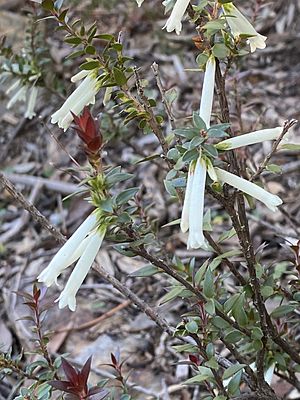Epacris sparsa facts for kids
Quick facts for kids Epacris sparsa |
|
|---|---|
 |
|
| Epacris sparsa growing in ANBG, Canberra | |
| Scientific classification |
Epacris sparsa is a small, upright shrub. It has pretty creamy-white flowers. Its leaves are shaped like eggs, and its new shoots are reddish. This plant grows only in New South Wales, Australia. It is found in only a few places.
Contents
What Epacris sparsa Looks Like
Epacris sparsa is an upright shrub. It usually grows about 60 to 90 centimeters (2 to 3 feet) tall. This plant has a special woody base called a lignotuber. This helps it regrow after a fire.
Its branches are brown and covered in soft, short hairs. The new parts of the plant often look reddish. The leaves stand mostly upright and are spaced out evenly. They are shaped like an ellipse or an egg. Each leaf is about 11 to 17 millimeters long and 3 to 4 millimeters wide. They have a pointed tip and smooth edges. When leaves fall off, they leave clear scars.
The creamy-white flowers grow one by one from where the leaves meet the stem. They can hang down or spread out. Each flower is about 19 millimeters long and 4 to 5 millimeters wide. The tips of the flowers have five small parts, like petals, about 4 millimeters long. This plant usually flowers from May to September.
How Epacris sparsa Got Its Name
This plant was first officially described in 1810. A famous botanist named Robert Brown gave it its scientific name. He wrote about it in a book called Prodromus florae Novae Hollandiae et insulae Van-Diemen, exhibens characteres plantarum quas annis 1802-1805.
The second part of its name, sparsa, comes from a Latin word. Sparsa means "scattered." Robert Brown thought the flowers were scattered because he collected the plant after it had mostly finished blooming. However, these plants often have many flowers!
Where Epacris sparsa Lives
Epacris sparsa has a very limited home range. It is only known to grow in four main areas in New South Wales. These places include Faulconbridge, the Grose River area, north of Richmond, and Avoca Vale Reserve.
You can find this plant in shady, rocky, and wet spots. It likes soils that don't have many nutrients, like clay or sandy soils. It can also handle times when there is a lot of rain.
Protecting Epacris sparsa
Because Epacris sparsa grows in so few places, it is considered "vulnerable." This means it is at risk of disappearing if we don't protect it. Both the Australian Government and the New South Wales government have laws to help protect this plant. These laws include the Environment Protection and Biodiversity Conservation Act 1999 and the Biodiversity Conservation Act 2016.

